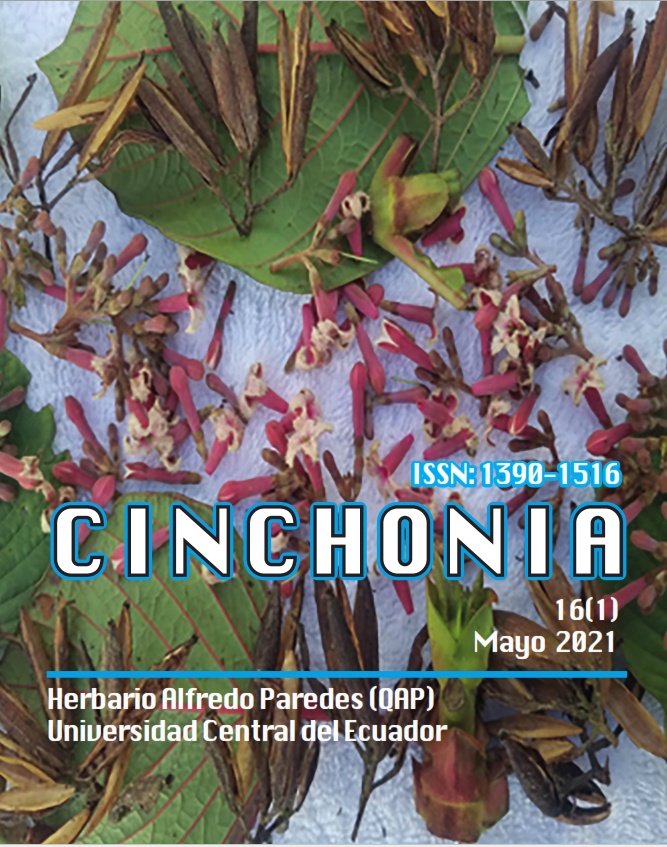Flora of the Chiquicahua River, Carihuayrazo volcano, Tungurahua - Ecuador
Main Article Content
Abstract
The primary river basin of the Chiquicahua River is located on the north side of the Carihuayrazo volcano glacier, Pilahuin 'parish, Ambato canton, Tungurahua province, coordinates, 78 ° 37.00W - 010 21.41 S (middle part), 3560 masl, plant formations: evergreen high montane forest and herbaceous moor. With the objective of characterizing the vegetation, during the month of August 2015, the botanical information was collected through the use of the transect methodology, in three locations (patches of disturbed forest), 0.1 ha, species > 2.5 were evaluated cm of DAP; and in two (herbaceous vegetation), 0.01 ha, species of all diameter; Herbalized samples from the study are deposited in the QAP herbarium; The results were analyzed using the indices: Simpson, Sorensen and Basal Area (AB). The results are: 108-1114 individuals and 9-42 species per transect, in total 123 species, 46 families, the most common habit is herbaceous, according to status 107 are native, 7 endemic (Aristeguietia glutinosa, Calceolaria ferruginea, Epidendrum tenuicaule, Gentianella cernua Grosvenoria hypargyra, Hypochaeris sonchoides and Polylepis retieulata) and 9 introduced, the interpretation of the Simpson Index is between low and above average, the .similarity ranges between 0% and 50%, the total AB is between 0.3 and 3.9m2 ; the most frequent species in each sampling are: Gynoxys sodiroi, Poa cucullata, Brachyotum ledifolium, Baccharis buxifolia and Anthoxanthum odoratum. The study area constitutes an ecosystem of disturbed forest and grassland patches due to the anthropic action, with heterogeneous vegetation, in different conservation states, the most common families are: Asteraceae, Poaceae, Polypodiaceae, Rosaceae, Dryopteridaceae, Gentianaceae and Lycopodiaceae, wasteland indicators; In addition to the biological, floristic, geological, water, landscape and tourist resources, the Cariguayrazo volcano offers ecosystem services such as water regulation, carbon sequestration, air cleaning, among others.
Article Details

This work is licensed under a Creative Commons Attribution-NonCommercial-NoDerivatives 4.0 International License.
References
Acosta Solís M (1994) Los Pajonales de Chiquicagua y la protección del río Colorado. Geográfica (Quito) 33: 7-18.
Balslev H (1983) Preparación de muestras botánicas. Pp. 45-48. En: Técnicas de Campo y Laboratorio. Museo Ecuatoriano de Ciencias Naturales, Quito.
Campbell DG, Daly D, Prance G & Maciel U (1986) Quantitative Ecological Inventory of Terra firme and Varzea Tropical Forest. Pp. 524-533. En: DG Cambell & HD Hammond (eds.). Floristic Inventory of Tropical Countries. New York Bot. Gard., NeW York-U.S.A.
Cañadas Cruz L (1983) El mapa bioclimático y ecológico del Ecuador. MAG-PRONAREG-Banco Central del Ecuador, Quito.Chimbolema S, uárez-Duque D, Peñafiel Cevallos M, Acurio C y Paredes T (sin año) Guía de plantas de la Reserva Ecológica El Ángel, DCG Impresores, Quito.
Cerón M CE (1994) Vegetación y Diversidad en la Reserva de Producción Faunística del Chimborazo-Ecuador. Geográfica (Quito) 33: 19-42.
Cerón M CE y Toasa G (1994) Diversidad de la Vegetación en el Volcán Rumiñahui, Pichincha-Ecuador. Geográfica (Quito) 34: 21-53.
Cerón Martínez CE (2015) Bases para el estudio de la flora ecuatoriana. Editorial Universitaria, Quito. Galeas R, Guevara JE, Medina-Torres
B, Chinchero MA y Herrera X (eds.)
(2013) Sistema de Clasificación de Ecosistemas del Ecuador Continental. Ministerio del Ambiente del Ecuador (MAE), Quito.
Hair JD (1980) Medida de la Diversidad Ecológica. Pp. 283-289. En: R. Rodríguez Tarrés (ed.). Manual de técnicas de gestión de la vida silvestre.
The Widlife Society, Maryland-U.S.A.Jørgensen PM & León-Yánez S (eds.) (1999) Catalogue of the Vascular Plants of Ecuador. Ann. Missouri Bot. Gard. 75: 1-1181.
Krebs Ch (1985) Ecología. Estudio de la distribución y la abundancia. 2da. Edición. Edit. Melo, S.A. México.León-Yánez S, Valencia R, Pitman N,
Endara L, Ulloa Ulloa C y Navarrete H (eds.) (2011) Libro rojo de las plantas endémicas del Ecuador. 2da. Edición: Publicaciones del Herbario QCA, Pontificia Universidad Católica del Ecuador, Quito.
Margalef R (1982) La diversidad. Pp. 359-382. Ecología. Ediciones Omega, S.A. Barcelona-España.Neill DA, Palacios W, Cerón CE y Mejía L (1993) Composition and Structure of Tropical Wet Forest in Amazonian Ecuador: Diversity and Edaphic Differentiation for Tropical Biology. Annual Meeting, Pto. Rico.
Neill DA y Ulloa Ulloa C (2011) Adiciones a la Flora del Ecuador: Segundo Suplemento, 2005-2010. Rg Grafistas, Quito.Sklenár P, Luteyn JL, Ulloa Ulloa C, Jørgensen PM y Dillon MO (2005) Flora Genérica de los Páramos, Guía Ilustrada de las Plantas Vasculares. Vol. 92. The New York Botanical Garden, New York-U.S.A.Ulloa Ulloa C y Neill DA (2005) Cinco años de adiciones en la Flora del Ecuador. 1999-2004. Edit. UTPL.
Universidad Particular de Loja, Loja Ecuador.Valencia R, Cerón CE, Palacios W y Sierra R (1999) Formaciones Naturales de la Sierra del Ecuador. Pp. 79-108. En Sierra R (ed.) Propuesta Preliminar de un Sistema de Clasificación de Vegetación para el Ecuador Continental. Proyecto
INEFAN/GEF-BIRF y EcoCiencia, Quito.
Viteri Robayo AG (1995) Fitosociología del Volcán Cariguairazo. Tesis doctoral en Biología. Escuela de Biología y Química, Facultada de Filosofía, Letras y Ciencias de la Educación, Universidad Central del Ecuador, Quito.
www.tropicos.org (Consultado el 12 de septiembre del 2020).

